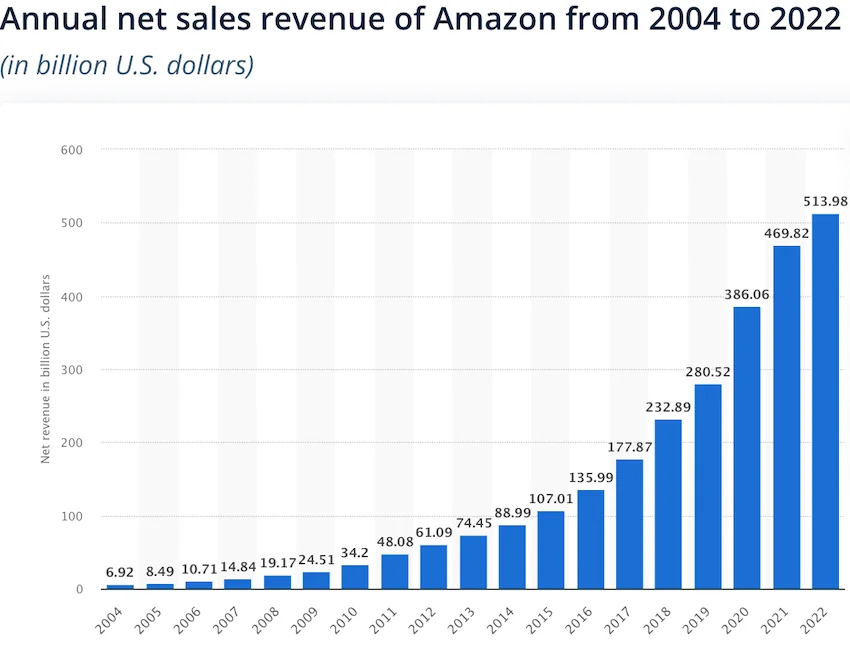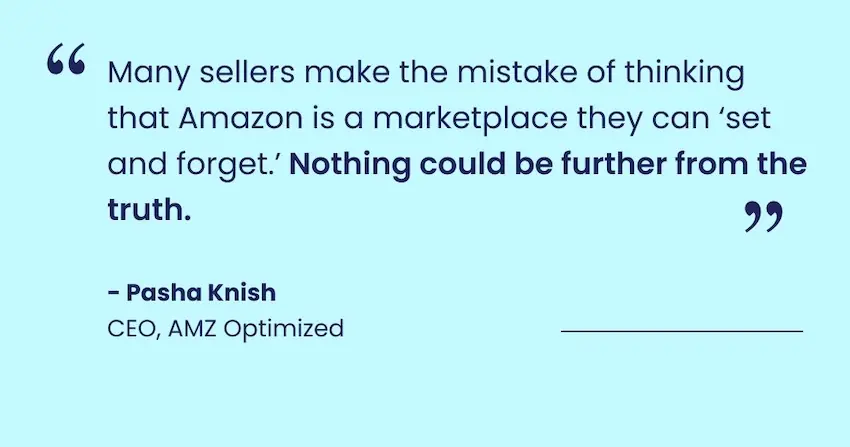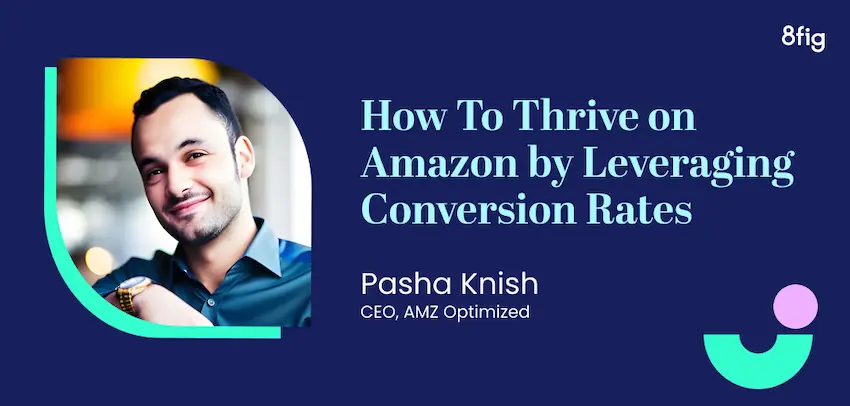This article was written by guest author and eCommerce expert Pasha Knish of AMZ Optimized.
Every eCommerce seller dreams of running a successful Amazon store. While there are alternatives like Walmart or Shopify, it is clear that Amazon is the leader of the bunch. Its immense reach and access to a huge network of consumers make it an ideal platform to operate from. However, thriving on Amazon is easier said than done. Its huge marketplace has attracted millions of sellers, creating a highly competitive environment for businesses. This means you need to stay on top of your game to stand out and succeed. Here are my biggest tips for thriving on Amazon.
Why Join Amazon in the First Place?
You may be wondering what actually makes Amazon better than alternative platforms. I have found that it is the friendliest to new sellers that are starting from scratch. For most categories of products, Amazon requires a relatively low initial investment and has few barriers to entry. Additionally, you can reach a global audience of millions of customers on one marketplace, which only very few platforms can offer. Thirdly, utilizing Amazon’s FBA (Fulfillment by Amazon) program allows your customers to enjoy free 2-day shipping, a significant asset to many shoppers.

As you can see from this Statista graph, Amazon has seen continuous sales growth over the past 18 years. This resilient growth is a good sign for eCommerce sellers that are still deciding where they want to list their products. Launching your brand on Amazon will give you access to a huge customer base that is consistently happy to spend larger and larger amounts.
Use Metrics to Your Advantage
One of the most important metrics for online stores is your conversion rate. It means the percentage of users who have completed a desired action. On Amazon, this translates to the percentage of shoppers visiting your page that turn into or convert into buyers. Understanding what percentage of shoppers land on your product detail page are purchasing allows you to gauge the success of your listing and identify areas for improvement. This can mean figuring out that you need to improve your copy or add elements like more CTAs (calls to action).
Ensuring you have appealing copy and images that tell your brand story and readily highlight the key benefits and differentiators is a significant contributing factor to improving conversion rates on Amazon.
Another crucial metric is sessions, which means the number of unique visits a listing gets within 24 hours. This is different from page views, which show how many times people entered your listing, even if it was one user coming back repeatedly. Sessions offer great insight into how appealing your products are, and whether you are able to generate meaningful interest.
Then, all sellers should keep Buy Box percentages in mind. The term defines the portion of times that your listing of a given product is selected when a customer decides to buy a product. This is only relevant in cases where other sellers also offer the products you sell. Having a good grasp of your Buy Box percentages gives you an additional metric to measure success by.
Buy Box percentages are very situational so a certain rate has very different meanings for two separate listings. For example, if you are one of 100 sellers offering an item and your Buy Box percentage is 5%, that would be seen as a success. On the other hand, if you are one of four sellers and you have a Buy Box percentage of 15%, that is probably not a good sign. It is directly proportional to how many sellers you are competing with. Understanding and leveraging this metric can have a big impact on your sales volume.
Scale Your Amazon Business
Many sellers make the mistake of thinking that Amazon is a marketplace they can ‘set and forget.’ Nothing could be further from the truth. Amazon may be attractive due to its relatively low barriers to entry and friendly start-up costs. But it also comes with a complex world of fast-paced competition, ever-changing algorithms, and a somewhat clunky back-end user interface. It’s important that regardless of the stage of your business on Amazon, you dedicate time and energy consistently to ensure you’re continually optimized for the platform.
This is also important due to Amazon’s constant changes. It was only recently that it introduced stock limits in its warehouses. Sellers have to adapt by developing an even more streamlined supply chain so they don’t risk running out of stock or overstocking and wasting money on storage costs. I recommend getting a 3PA (third-party logistics provider) for this exact situation. It enables you to store inventory at a cheaper price, and then ship it to your Amazon warehouse quickly and at a reasonable price when your stock runs low.

Here are some key tips for sustained growth:
- Ensure your listings are optimized for a stellar shopping experience while also crafted for SEO performance. This means having great copy as well as crisp, high-quality pictures or even videos that give shoppers an engaging preview of your product.
- Keep tabs on your inventory management systems to ensure you’re balancing a healthy level of stock and streamlining fulfillment. Ensuring that your products travel seamlessly from suppliers to your warehouses and then to customers is essential. An effective supply chain means faster shipping times for customers, as well as lower expenses. Bloating your inventory to levels you can’t sell rapidly will lead to extra storage costs. Running out of stock means lost sales, stunted keyword growth, and a smaller market share.
- Continually optimize ads to improve performance and return on investment over time. The closer you monitor your metrics, the more areas for improvement you will identify. You need to identify which ad campaigns manage to turn heads and should be boosted with more funding, and which need to be improved or discontinued. Knowing which keywords, timeslots, regions and groups to target can make a major difference in the effectiveness of your ads.
Stay on Top of Your Amazon Game
Here are a few additional factors you should keep in mind to succeed on Amazon:
- Make sure you’re priced competitively. Finding the sweet spot between a high profit margin and a competitive price point is key to moving your products. Do market research to get a proper understanding of how competitors do it. And remember: offering comparatively high prices can work out if your marketing strategy is able to generate enough demand.
- Stay on top of customer reviews and feedback. If you see the same positive or negative feedback more than once, take notice. If it’s positive, make sure these points are generously highlighted throughout your listing so other potential buyers will notice this benefit right away. If the feedback is negative, see if there’s something you can do to adjust customer expectations or modify your offering.
- List your items correctly. Many sellers don’t take the time to research the proper category or variation set up for the items they offer. Listing your items correctly ensures that your customers have the best shopping experience possible and reduces the chance of returns.
to our blog
Read the latest
from 8fig

From AI-powered styling to virtual try-ons, learn about the innovations transforming the fashion industry and enhancing the shopping experience.

Explore the pros and cons of lump sum loans vs. just-in-time funding, and discover why JIT funding could be the game-changer your eCommerce business needs.
![BFCM: The ultimate guide to eCommerce sales [2024]](https://www.8fig.co/wp-content/uploads/2023/09/cover-2-768x432.jpg.webp)
Get ready for Black Friday and Cyber Monday with our guide on maximizing sales through smart inventory management, effective marketing strategies, and leveraging eCommerce financing.
